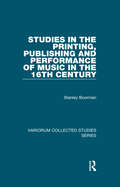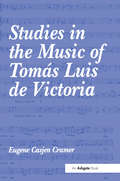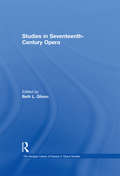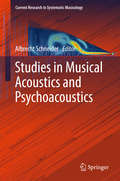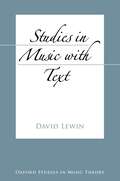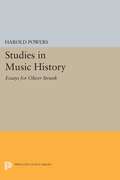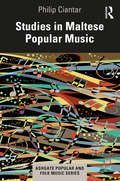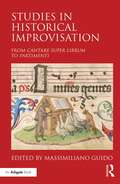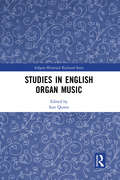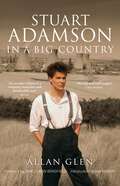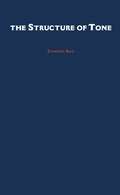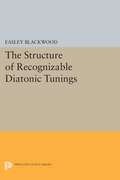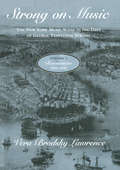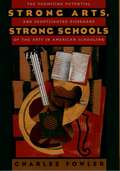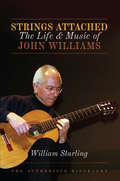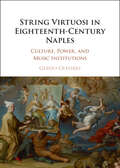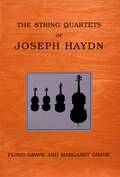- Table View
- List View
Studies in the Printing, Publishing and Performance of Music in the 16th Century
by Stanley BoormanThe emergence of music printing and publishing in the early 16th century radically changed how music was circulated, and how the musical source (printed or manuscript) was perceived, and used in performance. This series of close studies of the structure and content of 16th-century and early 17th-century editions (and some manuscripts) of music draws conclusions in a number of areas - printing techniques for music; the habits of different type-setters and scribes, and their view of performing practice; publishers' approaches to the musical market and its abilities and interests; apparent changes of plan in preparing editions; questions of authorship; evidence in editions and manuscripts for interpreting different levels of notation; ways in which scribes could influence performers' decisions, and others by which composers could exploit unusual sonorities.
Studies in the Music of Tomás Luis de Victoria
by EugeneCasjen CramerRepresenting nearly thirty years of research by one of the leading scholars in the field, this series of in-depth studies examines selected aspects of the music of the great Spanish composer in the late Renaissance, Tom Luis de Victoria. Presenting new insights into both the musical style and language and the compositional procedure of this contemporary of Palestrina, Lasso and Byrd, Eugene Cramer illuminates the extent to which Victoria's compositions are musically related. The book reveals that the falsobordone or fabord layed a much larger role in Victoria's music than has previously been thought. Cramer also demonstrates that Victoria's parody or imitation technique, especially in respect to his Masses of 1592, extended the parameters that are generally thought to be characteristic of works of this type. Of special interest is the discussion of thirty-eight works, including thirty-four psalm settings that are attributed to Victoria in extant manuscript sources. Extensively illustrated with over 130 musical examples, these studies will not only interest the serious student of sacred music, but also the performer, both the singer and the conductor alike.
Studies in the Music of Tomás Luis de Victoria
by EugeneCasjen CramerRepresenting nearly thirty years of research by one of the leading scholars in the field, this series of in-depth studies examines selected aspects of the music of the great Spanish composer in the late Renaissance, Tom Luis de Victoria. Presenting new insights into both the musical style and language and the compositional procedure of this contemporary of Palestrina, Lasso and Byrd, Eugene Cramer illuminates the extent to which Victoria's compositions are musically related. The book reveals that the falsobordone or fabord layed a much larger role in Victoria's music than has previously been thought. Cramer also demonstrates that Victoria's parody or imitation technique, especially in respect to his Masses of 1592, extended the parameters that are generally thought to be characteristic of works of this type. Of special interest is the discussion of thirty-eight works, including thirty-four psalm settings that are attributed to Victoria in extant manuscript sources. Extensively illustrated with over 130 musical examples, these studies will not only interest the serious student of sacred music, but also the performer, both the singer and the conductor alike.
Studies in Seventeenth-Century Opera
by BethL. GlixonThe past four decades have seen an explosion in research regarding seventeenth-century opera. In addition to investigations of extant scores and librettos, scholars have dealt with the associated areas of dance and scenery, as well as newer disciplines such as studies of patronage, gender, and semiotics. While most of the essays in the volume pertain to Italian opera, others concern opera production in France, England, Spain and the Germanic countries.
Studies in Seventeenth-Century Opera
by BethL. GlixonThe past four decades have seen an explosion in research regarding seventeenth-century opera. In addition to investigations of extant scores and librettos, scholars have dealt with the associated areas of dance and scenery, as well as newer disciplines such as studies of patronage, gender, and semiotics. While most of the essays in the volume pertain to Italian opera, others concern opera production in France, England, Spain and the Germanic countries.
Studies in Musical Acoustics and Psychoacoustics (Current Research in Systematic Musicology #4)
by Albrecht SchneiderThis book comprises twelve articles which cover a range of topics from musical instrument acoustics to issues in psychoacoustics and sound perception as well as neuromusicology. In addition to experimental methods and data acquisition, modeling (such as FEM or wave field synthesis) and numerical simulation plays a central role in studies addressing sound production in musical instruments as well as interaction of radiated sound with the environment. Some of the studies have a focus on psychoacoustic aspects in regard to virtual pitch and timbre as well as apparent source width (for techniques such as stereo or ambisonics) in music production. Since musical acoustics imply subjects playing instruments or singing in order to produce sound according to musical structures, this area is also covered including a study that presents an artificial intelligent agent capable to interact with a real ('analog') player in musical genres such as traditional and free jazz.
Studies in Music with Text (Oxford Studies in Music Theory)
by David LewinThroughout his career, David Lewin labored to make even the most abstract theory speak to the experience of the ordinary listener. This book combines many of Lewin's classic articles on song and opera with newly drafted chapters on songs of Brahms, Robert Schumann, Clara Schumann, and Milton Babbitt. Bound together by Lewin's cogent insight, the resulting collection constitutes a major statement concerning the methodological problems associated with interpretation of texted music.
Studies in Music with Text (Oxford Studies in Music Theory)
by David LewinThroughout his career, David Lewin labored to make even the most abstract theory speak to the experience of the ordinary listener. This book combines many of Lewin's classic articles on song and opera with newly drafted chapters on songs of Brahms, Robert Schumann, Clara Schumann, and Milton Babbitt. Bound together by Lewin's cogent insight, the resulting collection constitutes a major statement concerning the methodological problems associated with interpretation of texted music.
Studies in Music History: Essays for Oliver Strunk
by Harold PowersA wide variety of essays by colleagues and former students reflect Professor Strunk's particular role as music historian, teacher, and a pre-eminent musicologist. Donald Grout provides the introduction and outlines the problems confronting musicology today. Other essays are devoted to early Christian music, Renaissance music, early Italian opera; Arthur Mendel writes on ambiguities of the munsural system, Edward Lowinsky on Willaert’s "Chromatic Duo," Joseph Kerman on Verdi, and Elliot Forbes on Beethoven.Originally published in 1958.The Princeton Legacy Library uses the latest print-on-demand technology to again make available previously out-of-print books from the distinguished backlist of Princeton University Press. These editions preserve the original texts of these important books while presenting them in durable paperback and hardcover editions. The goal of the Princeton Legacy Library is to vastly increase access to the rich scholarly heritage found in the thousands of books published by Princeton University Press since its founding in 1905.
Studies in Maltese Popular Music (Ashgate Popular and Folk Music Series)
by Philip CiantarThis book examines the diverse facets of popular music in Malta, paying special attention to għana (Malta’s folk song), the wind band tradition, and modern popular music. Ciantar provides intriguing discussions and examples of how popular music on this small Mediterranean island country interacts with other aspects of the island’s life and culture such as language, religion, history, customs, and politics. Through a series of ethnographic vignettes, the book explores the music as it takes place in bars, at festivals, and during village celebrations, and considers how it is talked about in the local press, at group gatherings, and on social media. The ethnography adopted here is that of a native musician and ethnomusicologist and therefore marries the author’s memories with ongoing observations and their evaluation.
Studies in Maltese Popular Music (Ashgate Popular and Folk Music Series)
by Philip CiantarThis book examines the diverse facets of popular music in Malta, paying special attention to għana (Malta’s folk song), the wind band tradition, and modern popular music. Ciantar provides intriguing discussions and examples of how popular music on this small Mediterranean island country interacts with other aspects of the island’s life and culture such as language, religion, history, customs, and politics. Through a series of ethnographic vignettes, the book explores the music as it takes place in bars, at festivals, and during village celebrations, and considers how it is talked about in the local press, at group gatherings, and on social media. The ethnography adopted here is that of a native musician and ethnomusicologist and therefore marries the author’s memories with ongoing observations and their evaluation.
Studies in Historical Improvisation: From Cantare super Librum to Partimenti
by Massimiliano GuidoIn recent years, scholars and musicians have become increasingly interested in the revival of musical improvisation as it was known in the Renaissance and Baroque periods. This historically informed practice is now supplanting the late Romantic view of improvised music as a rhapsodic endeavour—a musical blossoming out of the capricious genius of the player—that dominated throughout the twentieth century. In the Renaissance and Baroque eras, composing in the mind (alla mente) had an important didactic function. For several categories of musicians, the teaching of counterpoint happened almost entirely through practice on their own instruments. This volume offers the first systematic exploration of the close relationship among improvisation, music theory, and practical musicianship from late Renaissance into the Baroque era. It is not a historical survey per se, but rather aims to re-establish the importance of such a combination as a pedagogical tool for a better understanding of the musical idioms of these periods. The authors are concerned with the transferral of historical practices to the modern classroom, discussing new ways of revitalising the study and appreciation of early music. The relevance and utility of such an improvisation-based approach also changes our understanding of the balance between theoretical and practical sources in the primary literature, as well as the concept of music theory itself. Alongside a word-centred theoretical tradition, in which rules are described in verbiage and enriched by musical examples, we are rediscovering the importance of a music-centred tradition, especially in Spain and Italy, where the music stands alone and the learner must distil the rules by learning and playing the music. Throughout its various sections, the volume explores the path of improvisation from theory to practice and back again.
Studies in Historical Improvisation: From Cantare super Librum to Partimenti
by Massimiliano GuidoIn recent years, scholars and musicians have become increasingly interested in the revival of musical improvisation as it was known in the Renaissance and Baroque periods. This historically informed practice is now supplanting the late Romantic view of improvised music as a rhapsodic endeavour—a musical blossoming out of the capricious genius of the player—that dominated throughout the twentieth century. In the Renaissance and Baroque eras, composing in the mind (alla mente) had an important didactic function. For several categories of musicians, the teaching of counterpoint happened almost entirely through practice on their own instruments. This volume offers the first systematic exploration of the close relationship among improvisation, music theory, and practical musicianship from late Renaissance into the Baroque era. It is not a historical survey per se, but rather aims to re-establish the importance of such a combination as a pedagogical tool for a better understanding of the musical idioms of these periods. The authors are concerned with the transferral of historical practices to the modern classroom, discussing new ways of revitalising the study and appreciation of early music. The relevance and utility of such an improvisation-based approach also changes our understanding of the balance between theoretical and practical sources in the primary literature, as well as the concept of music theory itself. Alongside a word-centred theoretical tradition, in which rules are described in verbiage and enriched by musical examples, we are rediscovering the importance of a music-centred tradition, especially in Spain and Italy, where the music stands alone and the learner must distil the rules by learning and playing the music. Throughout its various sections, the volume explores the path of improvisation from theory to practice and back again.
Studies in English Organ Music (Ashgate Historical Keyboard Series)
by Iain QuinnStudies in English Organ Music is a collection of essays by expert authors that examines key areas of the repertoire in the history of organ music in England. The essays on repertoire are placed alongside supporting studies in organ building and liturgical practice in order to provide a comprehensive contextualization. An analysis of the symbiotic relationship between the organ, liturgy, and composers reveals how the repertoire has been shaped by these complementary areas and developed through history. This volume is the first collection of specialist studies related to the field of English organ music.
Studies in English Organ Music (Ashgate Historical Keyboard Series)
by Iain QuinnStudies in English Organ Music is a collection of essays by expert authors that examines key areas of the repertoire in the history of organ music in England. The essays on repertoire are placed alongside supporting studies in organ building and liturgical practice in order to provide a comprehensive contextualization. An analysis of the symbiotic relationship between the organ, liturgy, and composers reveals how the repertoire has been shaped by these complementary areas and developed through history. This volume is the first collection of specialist studies related to the field of English organ music.
Stuart Adamson: In a Big Country
by Allan GlenThis is the book that fans of the Skids, Big Country and the Raphaels have been waiting for - a critical perspective not only of Adamson's music and its wider cultural influence, but also the excesses of fame and how the music business really works. Stuart Adamson: In a Big Country tells the story of how a teenager who was raised in a small Fife village released his first single at 19, wrote three Top 40 albums in the next three years and was written off as a has-been at 23, but then went on to form a new band and sell more than 10 million records worldwide, touring with the Rolling Stones and David Bowie. Although Stuart Adamson was one of the most respected and popular figures in the music industry, his personal life was complex - depression, alcoholism and estrangement - and ultimately tragic, ending with his suicide in a Hawaiian hotel in December 2001.
The Structure Of Tone
by Zhiming BaoThis book argues a fresh theory about the structure of tone. Bao investigates a wide range of tone sandhi data from various Chinese dialects and other Asian tone languages, providing empirical support for his proposal that tone is a formal entity which consists of register and contour. Bao establishes a clear typological distinction between register tone languages and contour tone languages whose contour tones have a more complex structure.
The Structure of Recognizable Diatonic Tunings
by Easley BlackwoodIn a comprehensive work with important implications for tuning theory and musicology, Easley Blackwood, a distinguished-composer, establishes a mathematical basis for the family of diatonic tunings generated by combinations of perfect fifths and octaves.Originally published in 1986.The Princeton Legacy Library uses the latest print-on-demand technology to again make available previously out-of-print books from the distinguished backlist of Princeton University Press. These editions preserve the original texts of these important books while presenting them in durable paperback and hardcover editions. The goal of the Princeton Legacy Library is to vastly increase access to the rich scholarly heritage found in the thousands of books published by Princeton University Press since its founding in 1905.
Strong on Music: The New York Music Scene in the Days of George Templeton Strong, Volume 1: Resonances, 1836-1849
by Vera Brodsky LawrenceIn Strong on Music Vera Brodsky Lawrence uses the diaries of lawyer and music lover George Templeton Strong as a jumping-off point from which to explore every aspect of New York City's musical life in the mid-nineteenth century. Formerly a concert pianist, Vera Brodsky Lawrence spent the last third of her life as a historian of American music (she died in 1996). She was editor of The Piano Works of Louis Moreau Gottschalk and The Complete Works of Scott Joplin. On Volume 1: "A marvelous book. There is nothing like it in the literature of American music."—Harold C. Schonberg, New York Times Book Review On Volume 2: "A monumental achievement."—Victor Fell Yellin, Opera Quarterly
Strong Arts, Strong Schools: The Promising Potential and Shortsighted Disregard of the Arts in American Schooling
by the late Charles FowlerIn this elegantly written, passionately argued book, Fowler presents a convincing case for teaching the arts to all children. He argues that, far from a luxury, the arts are a vitally important part of our society and our schools. Highlighting the crucial effect of the arts on learning, this volume shows how the arts can enliven and extend the entire school curriculum by integrating different subjects in innovative interdisciplinary ways. These eighteen compelling essays are a clarion call to action for any teacher, parent, policy maker, or citizen concerned about the fate of the arts in American society and schools.
Strong Arts, Strong Schools: The Promising Potential and Shortsighted Disregard of the Arts in American Schooling
by the late Charles FowlerIn this elegantly written, passionately argued book, Fowler presents a convincing case for teaching the arts to all children. He argues that, far from a luxury, the arts are a vitally important part of our society and our schools. Highlighting the crucial effect of the arts on learning, this volume shows how the arts can enliven and extend the entire school curriculum by integrating different subjects in innovative interdisciplinary ways. These eighteen compelling essays are a clarion call to action for any teacher, parent, policy maker, or citizen concerned about the fate of the arts in American society and schools.
Strings Attached: The Life and Music of John Williams
by William StarlingStrings Attached is the much anticipated authorised biography of John Williams, one of the most accomplished and celebrated musicians of his generation. From his childhood in Australia to his stellar career in London and around the world, John Williams has lived an extraordinary life. Master of the classical repertoire, he took the guitar to a wider audience with the band SKY and by his championing of the music of South America and Africa. William Starling came to know John Williams through their mutual friend, jazz guitarist John Etheridge. As their friendship developed, he put it to the maestro that it was time for a biography. To his lasting amazement, the famously private Williams agreed. Strings Attached is the product of extensive research and uniquely privileged access to John Williams, his family, friends and musical associates. It is the first telling of the fascinating life and career of a world-renowned musician and, equally, the story of a man and the making of his identity.
String Virtuosi in Eighteenth-Century Naples: Culture, Power, And Music Institutions
by Guido OlivieriThe String Quartets of Joseph Haydn
by Floyd Grave Margaret GraveRenowned music historians Floyd and Margaret Grave present a fresh perspective on a comprehensive survey of the works. This thorough and unique analysis offers new insights into the creation of the quartets, the wealth of musical customs and conventions on which they draw, the scope of their innovations, and their significance as reflections of Haydn's artistic personality. Each set of quartets is characterized in terms of its particular mix of structural conventions and novelties, stylistic allusions, and its special points of connection with other opus groups in the series. Throughout the book, the authors draw attention to the boundless supply of compositional strategies by which Haydn appears to be continually rethinking, reevaluating, and refining the quartet's potentials. They also lucidly describe Haydn's famous penchant for wit, humor, and compositional artifice, illuminating the unexpected connections he draws between seemingly unrelated ideas, his irony, and his lightning bolts of surprise and thwarted expectation. Approaching the quartets from a variety of vantage points, the authors correct many prevailing assumptions about convention, innovation, and developing compositional technique in the music of Haydn and his contemporaries.
The String Quartets of Joseph Haydn
by Floyd Grave Margaret GraveRenowned music historians Floyd and Margaret Grave present a fresh perspective on a comprehensive survey of the works. This thorough and unique analysis offers new insights into the creation of the quartets, the wealth of musical customs and conventions on which they draw, the scope of their innovations, and their significance as reflections of Haydn's artistic personality. Each set of quartets is characterized in terms of its particular mix of structural conventions and novelties, stylistic allusions, and its special points of connection with other opus groups in the series. Throughout the book, the authors draw attention to the boundless supply of compositional strategies by which Haydn appears to be continually rethinking, reevaluating, and refining the quartet's potentials. They also lucidly describe Haydn's famous penchant for wit, humor, and compositional artifice, illuminating the unexpected connections he draws between seemingly unrelated ideas, his irony, and his lightning bolts of surprise and thwarted expectation. Approaching the quartets from a variety of vantage points, the authors correct many prevailing assumptions about convention, innovation, and developing compositional technique in the music of Haydn and his contemporaries.
